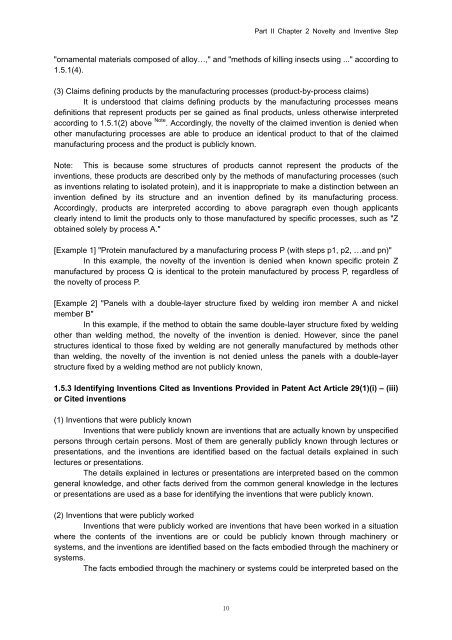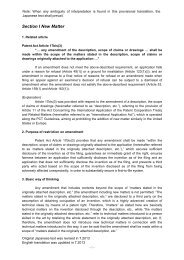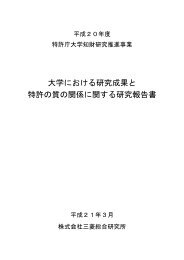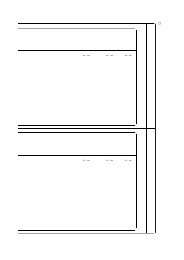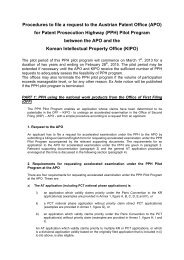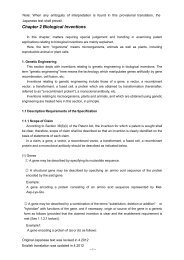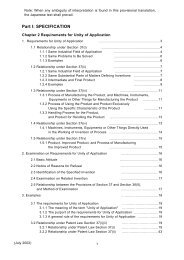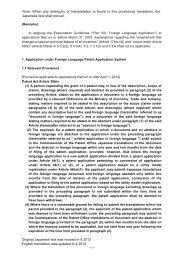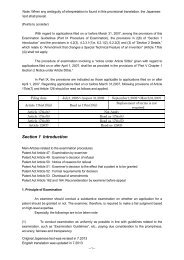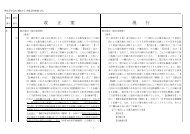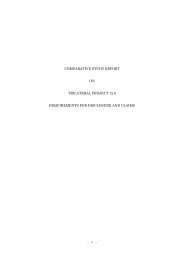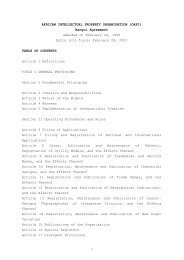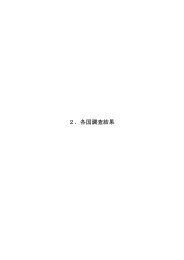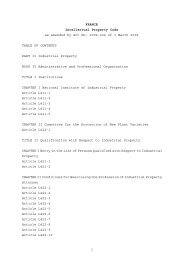Chapter 2 Novelty and Inventive Step - Japan Patent Office
Chapter 2 Novelty and Inventive Step - Japan Patent Office
Chapter 2 Novelty and Inventive Step - Japan Patent Office
You also want an ePaper? Increase the reach of your titles
YUMPU automatically turns print PDFs into web optimized ePapers that Google loves.
Part II <strong>Chapter</strong> 2 <strong>Novelty</strong> <strong>and</strong> <strong>Inventive</strong> <strong>Step</strong><br />
"ornamental materials composed of alloy…," <strong>and</strong> "methods of killing insects using ..." according to<br />
1.5.1(4).<br />
(3) Claims defining products by the manufacturing processes (product-by-process claims)<br />
It is understood that claims defining products by the manufacturing processes means<br />
definitions that represent products per se gained as final products, unless otherwise interpreted<br />
according to 1.5.1(2) above Note . Accordingly, the novelty of the claimed invention is denied when<br />
other manufacturing processes are able to produce an identical product to that of the claimed<br />
manufacturing process <strong>and</strong> the product is publicly known.<br />
Note: This is because some structures of products cannot represent the products of the<br />
inventions, these products are described only by the methods of manufacturing processes (such<br />
as inventions relating to isolated protein), <strong>and</strong> it is inappropriate to make a distinction between an<br />
invention defined by its structure <strong>and</strong> an invention defined by its manufacturing process.<br />
Accordingly, products are interpreted according to above paragraph even though applicants<br />
clearly intend to limit the products only to those manufactured by specific processes, such as "Z<br />
obtained solely by process A."<br />
[Example 1] "Protein manufactured by a manufacturing process P (with steps p1, p2, …<strong>and</strong> pn)"<br />
In this example, the novelty of the invention is denied when known specific protein Z<br />
manufactured by process Q is identical to the protein manufactured by process P, regardless of<br />
the novelty of process P.<br />
[Example 2] "Panels with a double-layer structure fixed by welding iron member A <strong>and</strong> nickel<br />
member B"<br />
In this example, if the method to obtain the same double-layer structure fixed by welding<br />
other than welding method, the novelty of the invention is denied. However, since the panel<br />
structures identical to those fixed by welding are not generally manufactured by methods other<br />
than welding, the novelty of the invention is not denied unless the panels with a double-layer<br />
structure fixed by a welding method are not publicly known,<br />
1.5.3 Identifying Inventions Cited as Inventions Provided in <strong>Patent</strong> Act Article 29(1)(i) – (iii)<br />
or Cited inventions<br />
(1) Inventions that were publicly known<br />
Inventions that were publicly known are inventions that are actually known by unspecified<br />
persons through certain persons. Most of them are generally publicly known through lectures or<br />
presentations, <strong>and</strong> the inventions are identified based on the factual details explained in such<br />
lectures or presentations.<br />
The details explained in lectures or presentations are interpreted based on the common<br />
general knowledge, <strong>and</strong> other facts derived from the common general knowledge in the lectures<br />
or presentations are used as a base for identifying the inventions that were publicly known.<br />
(2) Inventions that were publicly worked<br />
Inventions that were publicly worked are inventions that have been worked in a situation<br />
where the contents of the inventions are or could be publicly known through machinery or<br />
systems, <strong>and</strong> the inventions are identified based on the facts embodied through the machinery or<br />
systems.<br />
The facts embodied through the machinery or systems could be interpreted based on the<br />
10


